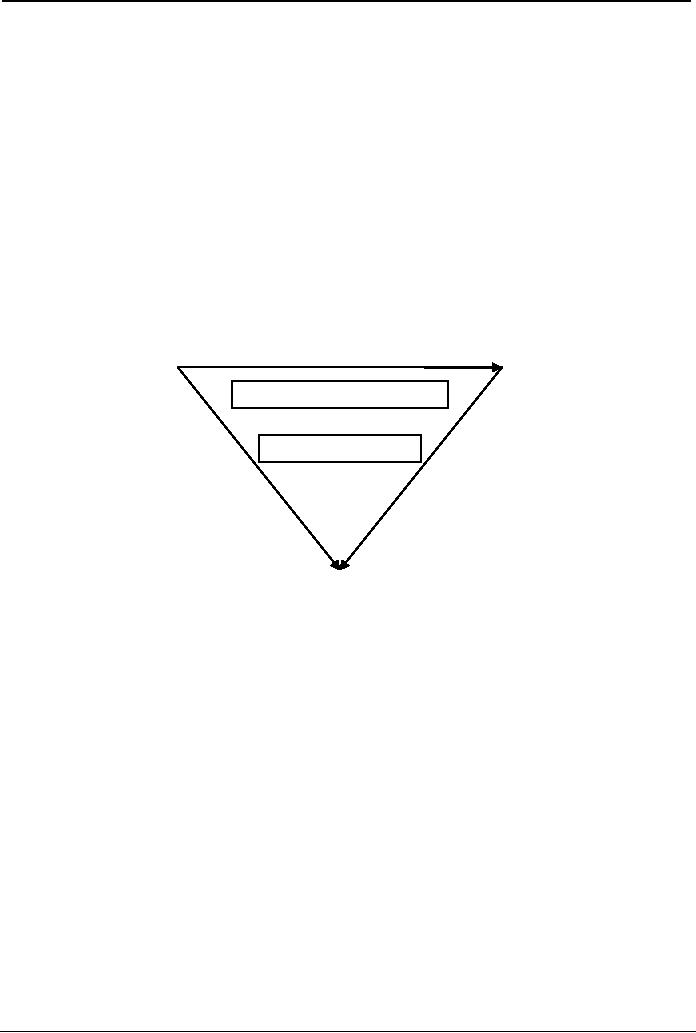 |
FUNDAMENTALS OF NEWS WRITING:Inverted Pyramided Style, Telling the Story |
| << RADIO NEWS GLOSSARY:Actuality, Cut, Voicer, Wrap, Hourly, Lead |
| FUNDAMENTALS OF WRITING NEWS FOR RADIO I:Language >> |

Radio
News, Reporting and Production
MCM515
VU
LESSON
27
FUNDAMENTALS
OF NEWS WRITING
The
first thing which a news
writer must keep in his
mind while writing a news
story is that the news
must
be
factual, objective and the language
employed must not be
flowery.
Inverted
Pyramided Style
The
main difference between news
writing and other forms of
prose, such as essay, short story,
novel,
article,
or feature, etc. is that the writers of
these forms usually begin with
minor details first and they
first
start
with comparatively insignificant details,
and then develop the flow of the
writing to the most
significant
information by the end of the writing;
whereas the news writer
reverses this style. In other
words
a
news writer starts writing
with the most significant information
and the rest of the details
are given near
the
end of the story.
This
style of news writing is
called inverted pyramid style
that is peculiar with news
writing. The inverted
pyramid
can be illustrated as following:
Most
important details of a News
Item
Intro
(Lead-headline)
Body
of the News
Least
important details of a News
Item
Essentials
of Radio News
Lead
The
lead or the headline or intro is the
starting sentence of a news item. It
contains the most
important
features
and the facts and figures of
the news story. Since it is the crux or the
gist of the event that is being
covered,
it needs to be short, crisp,
comprehensive and catchy.
Keeping the interest of the listener
alive
throughout
the bulletin and making him wait
for the detailed news, all
depends upon the lead. Radio
news
presentation
is different from that of the
newspaper in a way that in
newspaper every headline is
followed
by
the detailed news but as far as
radio is concerned, this technique is
simply impossible. Here the
headlines
of
all the news items to be included in the
bulletin are read out at the
start of the bulletin and
then the news
in
detail goes on air. That is
why writing lead for
radio news bulletin requires
more skill and proficiency
on
the
part of the news
writer.
A
headline is normally a brief
summery of the main points of the story
and must be completed within
a line
comprising
word not more than 48 in
any way.
Body
This
is the detailed version of the news item whose
headline has already been
read out by the start of
the
news
bulletin. This part of the news
bulletin may contain an actuality, voicer or
wrap depending upon
the
requirement of the news item.
75

Radio
News, Reporting and Production
MCM515
VU
In
five-minute news bulletin, however,
actuality, or other insertions are
not possible to be made a
part of
the
bulletin owing to the time
restraints.
Details
While
penning down the body of the
news story a news writer
must not forget to include
any important
point
of the news item. All the details
must be arranged in the
body.
Paragraphs
If
the news item is pretty lengthy yet
important, the story must be written in
paragraphs. In this way the
newscaster
will be at ease while
reading out the news
item.
Chronological
order of the
events
Another
important thing that the
news writer needs to focus
is the Chronological
order of the
events. If
the
event being covered extends to dates or
different times in the same
day, the chronological order is to
be
maintained.
It means that the different
parts and portions of the
same news item must be
arranged
according
to the order they have taken
place.
Paul
White (CBS News Director)
Formula
The
format and the style of
radio news bulletin is well
explained by Paul Whit who
had been serving
CBS
news
as director. The style
described by Mr. White is
called Paul
Whit Formula that
goes like this:
"Tell
them what you are
going to tell them, tell
them, and then tell
them that you have
told them."
The
formula actually explains
that in a radio news
bulletin, first the audience
must be told the head
lines
(Tell
them what you are
going to tell them),
then news in detail must be
read out (tell
them), and
finally
the
headlines once again are to
be told by before the bulletin ends
(and
then tell them that
you have told
them).
Essentials
of Radio News
Writing
The
essentials of writing news
for radio, by and large, are
the same as are the essentials of
writing for radio
in
general. The news writer
must keep the following
truths in his/her mind while
writing news for
radio:
For
ear---not for eye
First
and the foremost truth about
writing for radio is that
you are writing for
ears not for eyes. It
simply
means
that whatever you are going
to write it will be heard
and it will not be read by
the audience. It is quite
obvious
that the written expression is
different from the spoken
one and it ought to be.
The content written
for
radio must be spoken and
lengthy sentences and difficult
vocabulary must be avoided.
Telling
the Story
You
must write for the radio in
a way that can be told
not read out. Telling a
story is an effective method
for
writing for radio.
If
you find it difficult to put
your thoughts down on paper
clearly and simply, use the
trick of
telling
someone out loud what
you want to say -----------------------------------------Harris
Watts, BBC.
Writing
for mass audience
While
writing for radio another
important truth must be kept
in mind that you are
writing for masses,
not
for
the intelligentsia of your society. Communication
means to convey the message in a
way that the target
audience
not only listen to it but
also understand it. For
securing this purpose it is necessary
that the
message
must be constructed coming to the level of the
audience.
Listener's
requirement is different from that of a
reader.
76
Table of Contents:
- WHAT RADIO IS:HISTORY OF RADIO, MARCONI –THE INVENTOR
- HISTORY OF RADIO:B.B.C. – 1922, Radio in Sub-Continent, PBC SERVICES
- OBJECTIVES OF BROADCASTING IN PAKISTAN:Information, Islamic ideology
- NEWS VALUES I:CONFLICT, PROGRESS, VICTORY AND DEFEAT
- NEWS VALUES II:TIMELINESS, PROXIMITY, NOVELTY, HUMAN INTEREST
- NEWS VALUES AND ELEMENTS OF NEWS:MISCELLANEOUS NEWS VALUES
- MEASURING THE IMPORTANCE OF NEWS:Intensity of an Event, NEWS STORY TYPES
- TYPES OF NEWS STORIES II:SIMPLE TYPES, ILLNESS, DEATH
- TYPES OF NEWS STORIES III:Conspiracy, Drug Trafficking, Lunar Months
- TYPES OF NEWS STORIES IV:COMPLEX NEWS, Forms of Government, Monarchy
- TYPES OF NEWS STORIES V:Education, Research, Religion
- TYPES OF NEWS STORIES VI:Lifestyles, Receptions, Entertainment
- SOURCES OF NEWS I:Network of Reporters, QUALITIES OF A REPORTER
- SOURCES OF NEWS II:MONITORING, NEWS/ PRESS RELEASE
- SOURCES OF NEWS III:National News Agencies, HARD NEWS, SOFT NEWS
- REPORTING:ORDER OF REPORTING, REPORTER’S QUALITIES, Well informed
- A SUCCESSFUL RADIO REPORTER:Briefing, Reporter’s Ammunition, Meeting Deadline
- INTERPRETATIVE REPORTING I:Growth of Interpretative Reporting
- INTERPRETATIVE REPORTING II:Factual Background, SPEECH STORY
- INTERPRETATIVE REPORTING III:FIRES & ACCIDENTS, CRIME STORIES
- INVESTIGATIVE REPORTING I:Thalidomide Scandal, Watergate Scandal
- INVESTIGATIVE REPORTING II:Identification of the problem, INTERVIEW
- TYPES OF INTERVIEW:Hard News Interview, Informational Interview
- ESSENTIALS OF A GOOD INTERVIEW I:Comments and Opinion, Topic must be specific
- ESSENTIALS OF A GOOD INTERVIEW II:Preparation of the Interview, Language
- RADIO NEWS GLOSSARY:Actuality, Cut, Voicer, Wrap, Hourly, Lead
- FUNDAMENTALS OF NEWS WRITING:Inverted Pyramided Style, Telling the Story
- FUNDAMENTALS OF WRITING NEWS FOR RADIO I:Language
- FUNDAMENTALS OF WRITING NEWS FOR RADIO II:Complex numbers
- ESSENTIALS OF A NEWSCASTER:Authority, Credibility, Language, Pronunciation
- PRODUCTION AND PLANNING:Principals of Planning a Program
- PRODUCER & BUDGETING:Strengths of a Radio Program, Budgeting a Program
- JARGONS OF PRODUCTION (Continued):Frequency spectrum, Dead studio
- TYPES OF TALK:Qualification of a Talker, Essentials of a talk, Vetting a talk
- DISCUSSION:Controlled Discussion, Live Discussion, Current affairs
- DISCUSSION:Selection of the TopicKnowledge of the Topic, Narrowing down the topic
- RADIO FEATURE:Sound Effects, Narration, Dramatic Feature, Religion, Personalities
- RADIO DOCUMENTARY:Commentary, History, Persons, Things, Phenomena
- DRAMA:Solo plays, Series, Serial, Soap, Components of Drama
- SPECIAL AUDIENCE PROGRAM:Children’s Programs, Women’s programs
- SPORTS PROGRAM:Live Programs, Recorded Programs, Preparation of OB
- THE MUSIC I:Folk Music, Classical Music, Light Music, Pop Music
- THE MUSIC II:Classification of Raga In Terms Of Notes, Aado, Khaado
- ETHICS & LIMITATIONS OF MEDIA:Domain of Freedom of Media, Defamation
- RECAP:What Radio Is, Timeliness, Elements of news, Types of Reporting, Production